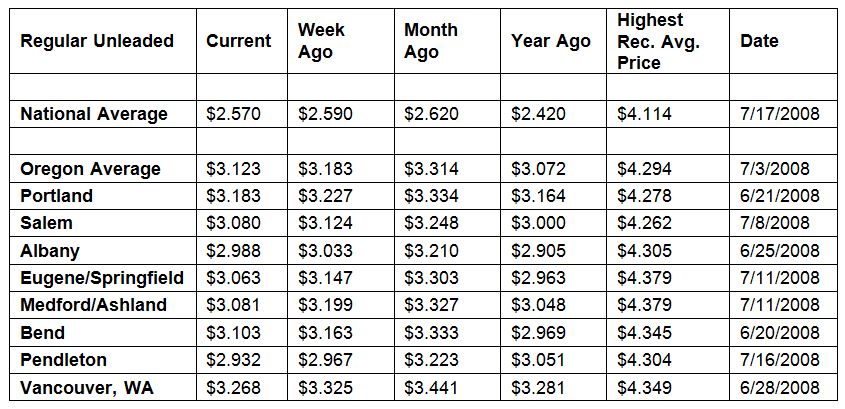PORTLAND, Ore., – Oregon drivers are enjoying gas prices that are falling more quickly than in other states. For the week, the national average for regular slips two cents to $2.57 a gallon. The Oregon average drops six cents to $3.12. This is the fourth-largest weekly decline in the nation. Oregon also has the second-largest monthly decline in the nation with a drop of 19 cents.
“Since the end of October, gasoline demand has mostly decreased as gasoline stocks have mostly increased, paving the way for cheaper pump prices,” says Marie Dodds, public affairs director for AAA Oregon/Idaho. “AAA expects gas prices to continue to trend lower between now and the end of the year.”
Oregon is one of 44 states and the District of Columbia where gas prices are lower now than a week ago; As mentioned above, Oregon (-6 cents) has the fourth-largest weekly decline in the country. California (-10 cents) has the largest week-over-week decline, Ohio (-9.5 cents) is second, and Nevada (-7 cents) is third. Florida (+8 cents) has the biggest weekly jump.
This week there are six states with an average above $3 a gallon, same as a week ago. For the fourth week in a row, there are no states with an average above $4 a gallon. California’s average had topped the $4 mark earlier this fall.
The cheapest gas in the nation can be found in Texas ($2.22) and Mississippi ($2.23). For the 43rd week in a row, no states have an average below $2 a gallon.
Oregon is one of 39 states with lower prices now than a month ago. The national average is five cents less and the Oregon average is 19 cents less than a month ago. This is the second-largest monthly decrease in the nation. California (-36 cents) has the largest month-over-month decline, Nevada (-16 cents) is third, and Washington (-15 cents) is fourth. Florida (+11 cents) has the largest month-over-month increase.
Oregon is one of 41 states where drivers are paying more than a year ago. The national average is 15 cents more and the Oregon average is five cents more than a year ago. Ohio (+32 cents) and Illinois (+30 cents) have the biggest year-over-year increases. Wyoming (-8 cents) has the largest year-over-year drop.
West Coast
The West Coast continues to have the highest pump prices in the nation with all of the region’s states landing on the top 10 most expensive list.
| Rank | Region | Price on 12/10/19 | |
| 1 | California | $3.69 | |
| 2 | Hawaii | $3.66 | |
| 3 | Washington | $3.26 | |
| 4 | Nevada | $3.21 | |
| 5 | Oregon | $3.12 | |
| 6 | Alaska | $3.10 | |
| 7 | Arizona | $2.90 | |
| 8 | Idaho | $2.89 | |
| 9 | Utah | $2.86 | |
| 10 | Colorado | $2.79 |
California is most expensive for the 12th week in a row, with Hawaii, Washington, Nevada, Oregon, Alaska and Arizona rounding out the top seven. Oregon is fifth most expensive for the 21st week in a row.
On the week, pump prices in the region continue to decline, with some states seeing the largest weekly drops in the country. California (-10 cents), Nevada (-7 cents) and Oregon (-6 cents) saw the largest decreases in the region.
Increased gasoline stocks continue to help put downward pressure on pump prices, as demand remains robust. According to EIA’s report for the week ending on November 29, gas stocks in the region grew by nearly 720,000 bbl, bringing the total to 29.59 million bbl. The current supply level is 1.86 million bbl higher than last year’s level at this time, which will likely continue to help prices in the region decline throughout the week.
Oil market dynamics
Crude oil prices rose last week after OPEC and its partners announced an agreement to cut crude production by an additional 500,000 b/d to help maintain prices amid market fears of slowing global demand. The new OPEC production reduction agreement brings the total production cut to 1.7 million b/d — which is about 100,000 b/d more than projected — beginning on January 1, 2020. The reduction in global crude supply is expected to help drain the market, which will likely be oversupplied during the first half of next year. It is unclear how long the new agreement will be in place, but OPEC will likely review it and announce any amendments at its next meetings on March 5 and 6 in Vienna, Austria.
One other contributing factor, if concerns around global crude demand due to the trade war between China and the U.S. ease this week, crude prices could increase again.
At the close of Friday’s formal trading session on the NYMEX, WTI increased by 77 cents to settle at $59.20. At the close of Monday’s formal trading session on the NYMEX, WTI slipped 18 cents to close at $59.02. Today crude is trading around $59, compared to $56 a week ago. Crude prices are up about four percent in the last month and are about $6 per barrel more than a year ago.
Drivers can find current gas prices along their route with the free AAA Mobile app for iPhone, iPad and Android. The app can also be used to map a route, find discounts, book a hotel and access AAA roadside assistance. Learn more at AAA.com/mobile.
Diesel
For the week, the national average drops a penny to just under $3.00 a gallon. Oregon’s average loses a nickel to $3.36. A year ago the national average for diesel was $3.11 and the Oregon average was $3.29.
Find current fuel prices at GasPrices.AAA.com.
AAA news releases, high resolution images, broadcast-quality video, fact sheets and podcasts are available on the AAA NewsRoom at NewsRoom.AAA.com.
Find local news releases at https://www.oregon.aaa.com/category/news-releases/



